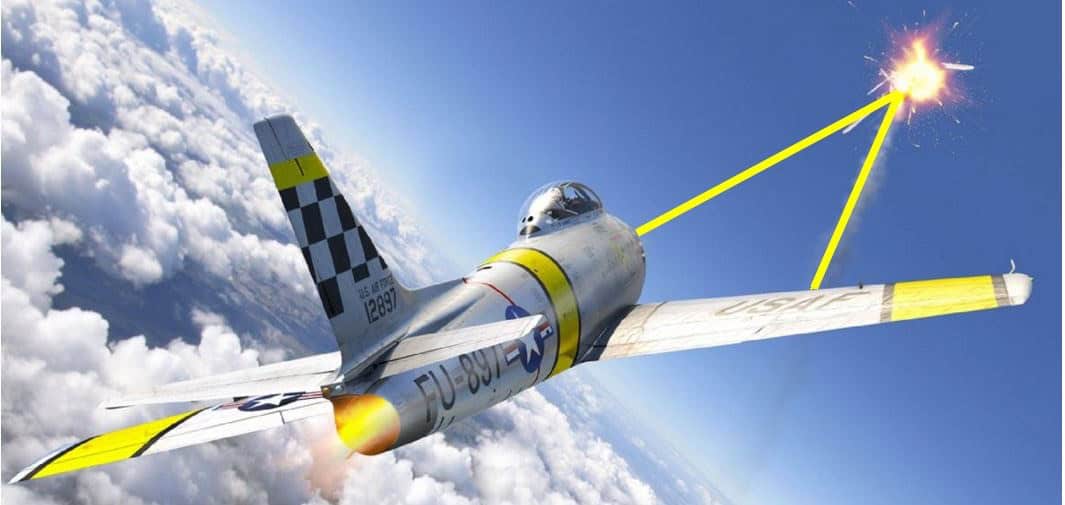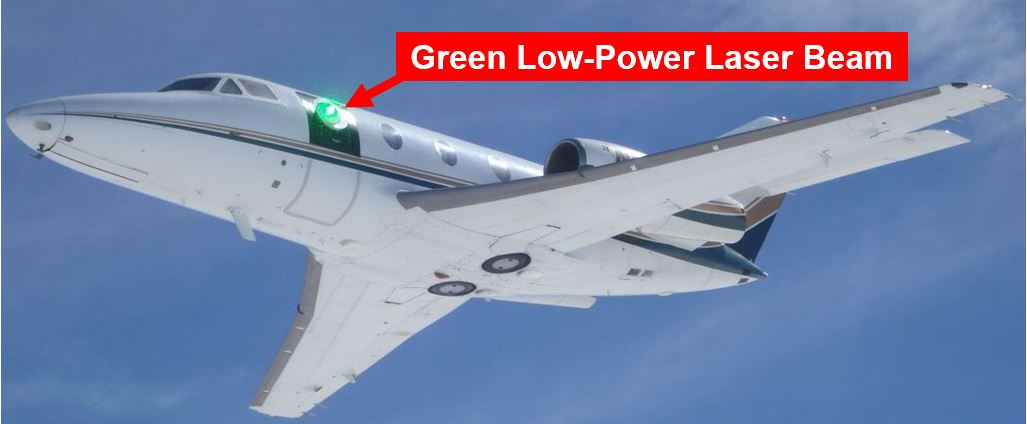US fighter jets will probably be equipped with laser guns and possibly a shield too, meaning they will be able to take out small targets from far away and be protected from missiles and bullets, giving them a huge advantage over enemy aircraft, says the US Air Force Research Laboratory (AFRL).
The AFRL, which is currently taking part in developing such technology, aims to give its first demonstration at the end of this decade.
Big planes are currently able to carry laser weapons. However, equipping smaller jet fighters with laser technology means making the equipment small enough so that the airplane’s speed and agility in the air are not undermined.
 Whichever air force in the world fits laser guns onto its fighter jets first will have control of the skies.
Whichever air force in the world fits laser guns onto its fighter jets first will have control of the skies.
Size is not the only issue with smaller, supersonic aircraft – accuracy is also crucial. The faster a plane goes, the more challenging the technology becomes in order to make sure it can hit the target accurately.
Chief Engineer for AFRL’s Directed Energy Directorate, Kelly Hammett, says these challenges should be overcome by 2020, with very small and ultra-accurate laser guns fitted onto US Air Force fighter jets.
Mr. Hammet said in an interview with CNN:
“It really is a national tipping point. We see the technology evolving and maturing to the stage where it really can be used.”
Not only laser weapons, but shields too
Imagine an ultra-agile warplane that can fly faster than the speed of sound, takes out tiny targets using its laser guns with amazing precision from far away, and has a shield that melts missiles and bullets that touch it.
This is what AFRL is also developing – a laser shield for airplanes. When ready, researchers believe it will destroy anything fired at it, thus protecting the whole aircraft.
If a plane cannot shake off a missile lock, the laser shield would be there as back-up protection. According to AFRL scientists, nothing the military has available today would be able to get through the shield.
 An experimental turret developed by Lockheed Martin for the the Air Force Research Laboratory and Defense Advanced Research Projects Agency controls and compensates for air flow, paving the way for laser weapon systems on jet fighters. In this picutre, low-power laser beam passes through the turret on a research aircraft. (Photo: Lockheed Martin. Credit: AFRL.)
An experimental turret developed by Lockheed Martin for the the Air Force Research Laboratory and Defense Advanced Research Projects Agency controls and compensates for air flow, paving the way for laser weapon systems on jet fighters. In this picutre, low-power laser beam passes through the turret on a research aircraft. (Photo: Lockheed Martin. Credit: AFRL.)
Speed and agility are king
It is vital, when using laser technology, that the fighter jet does not lose speed or agility in the air. If it did, it would be at a disadvantage against enemy aircraft.
For any major air force across the globe, speed is king, as far as fighter jets are concerned. It does not matter how sophisticated the rest of the plane is, if it does not have speed it is unlikely to have the upper hand.
Lockheed Martin, the US multinational aerospace, defense and security giant, the Defense Advanced Research Projects Agency (DARPA) and AFRL are collaborating on a project to develop an effective laser shield turret. In fact, they have already tested one.
According to Lockheed Martin, its Aero-adaptive Aero-optic Beam Control (ABC) turret is the only one in the world today from which a laser weapon can fire in every direction, i.e. with a 360-degree field of regard, when the airplane is flying nearly at the speed of sound.
 Will we ever be able to shoot at targets on Earth from space? If so, how would that change the dynamics of war?
Will we ever be able to shoot at targets on Earth from space? If so, how would that change the dynamics of war?
Lockheed Martin says it has carried out nearly 60 turret test flights in 2014 and 2015, using a business jet as a low-cost flying test bed.
The Bethesday-based company said:
“As the aircraft travelled at jet cruise speeds, a low-power laser beam was fired through the turret’s optical window to measure and verify successful performance in all directions.”
Dynamics of war will change with lasers
How wars and battles were fought and won (or lost) has changed considerably throughout history. Spears and clubs gave way to bows and arrows, which meant man-to-man combat was not the only way to kill your enemy. Things changed again when guns were introduced, and then in the First World War chemical weapons (mustard gas) came onto the scene.
In the Second World War, when airplanes took part in battles and missions, war was also fought in the skies. Then came drones, which can be used without pilots.
Mr. Hammet says laser attack and defensive technology will again dramatically change how battle and mission strategies are decided over the next twenty-five years.
What is a laser weapon?
The word ‘laser’ is short for Light Amplification by Stimulated Emission of Radiation. It is an extremely intense, highly directional beam of light.
According to Northrop Grumman Corporation, an American aerospace and defense technology company:
“A laser is commonly produced by ‘exciting’ the atoms or molecules in a material in a very controlled manner until they emit photons, or packets of light, in a very organized or coherent fashion. In chemical lasers, the excited species are formed by a chemical reaction and the energy provided to the system is stored as chemicals.”
“In a solid state laser, the excited species is formed by optical excitation and the energy is provided to the system electrically. This electrical energy can be stored in batteries, flywheels or in fuel for generators. In both cases a population inversion is formed, which allows stimulated emission. Optical extraction occurs using an optical resonator, which can be as simple as a pair of mirrors surrounding the excited gain medium.”
A laser is a special source of light of only one pure color. Unlike normal light, you can’t break up laser light into other colors. For example, a laser beam that goes through a prism comes out the same on the other side.
Laser weapons work by concentrating light beams on a target. The laser beam can cut through almost anything, including metal or glass.
A laser gun destroys an enemy target by igniting it, i.e. literally destroying it by burning it up.
Mr. Hammet says the force of a laser weapon and how long the beam can be held depends on how much electrical power is applied.
This means laser technology uses energy, which must be stored on a jet fighter. That is something else researchers have to factor in – how much fuel or stored energy the aircraft can carry without affecting its flying performance.
Laser beams are remarkably accurate. A fighter jet with a laser weapon would be able to ignite very small targets from far away, and with the minimum of collateral damage.
AFRL also plans to fit laser weapons onto drones, which would mean battles could be fought and missions done without needing to risk pilots’ lives.
Mr. Hammet does not believe laser technology would initially be used for offensive tactics. It would probably be used to help airplanes secure hot landing zones, for example.
Lockheed Martin says:
“Science reality has caught up with science fiction. Lockheed Martin is showing that laser weapon systems can turn up the heat and stop land, air or sea targets in their path. And, they can be compact enough and power efficient enough for tactical platforms on the move, providing nearly unlimited “bullets” with speed-of-light response.”
Video – Military laser weapons
